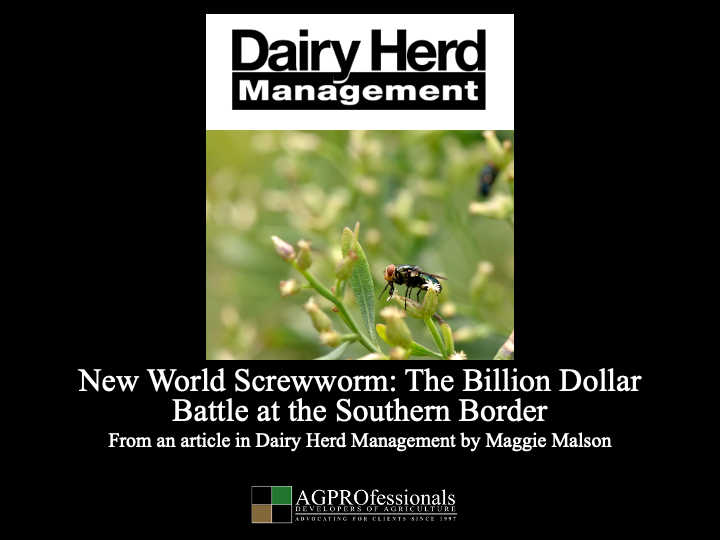“Nearly 60 years ago, the U.S. eradicated New World screwworm (NWS). Today, the risk of reintroduction is real. So real that Ethan Lane with the National Cattlemen’s Beef Association (NCBA) says it’s not a matter of if NWS will reach the U.S. but when.
“We need to spend $300 million now to save us $8 billion down the line in eradication costs,” says Lane, who serves as the senior vice president of government affairs. “This is a marathon, not a sprint, and it’s going to take years to re-eradicate New World Screwworm and push it back to Panama.”
As the fight to keep NWS out of the U.S. ramps up, the economic impact on ranchers and the industry is top of mind.
“Successfully eradicating New World screwworm from the U.S. in 1966 cost stakeholders’ tens of millions of dollars,” says TR Lansford III, DVM, deputy executive director and assistant state veterinarian with the Texas Animal Health Commission. “The freedom from NWS provides an estimated $1 billion in direct benefits to livestock producers and $3.7 billion in benefits to the general economy annually.”
Financial Impact of NWS On Ranchers
Regular, large-scale outbreaks of NWS started occurring in the U.S. in the 1930s. According to APHIS, producer losses have reached:
- 1930s and 1940s — $5 million to $10 million per year
- 1950s and 1960s — $60 million to $120 million per year
- 1970s — $132.1 million per year (While the U.S. successfully eradicated the devastating pest, there have been outbreaks, primarily in Texas, since then.)
Experts agree if NWS reaches the U.S., eradication today will be far more expensive due to the size of the cattle herd, speed and distance of cattle movement in commerce, and increased wildlife interfaces.
“Historically it cost tens of millions, and now it’s estimated to cost into the billions of dollars to eradicate this pest if it gets back to the U.S,” Lansford says.
Based on historical data from an isolated outbreak in Texas in 1976, per-head impact reached $452 in today’s dollars, totaling $732 million.
“[NWS] is a highly impactful foreign animal pest because it is expensive and deadly,” Lansford says. “Back in 1935, when screwworms were endemic in Texas, the state lost about 180,000 head of cattle alone in that year.”
Lansford says the industry will see decreased livestock production and increased veterinary services, medication, insecticide, labor and vehicle costs for the inspection and treatment of NWS.
“Infested wounds and/or mucous membranes and lesions created by this pest cause significant distress and damage to an animal, which can lead to chronic conditions making the animal less marketable and less productive in its lifespan,” he adds.
USDA Investment to Fight NWS
The reopening of Moore Air Base in Texas as a sterile fly distribution facility has an estimated price tag of $8.5 million. A brand new production facility, which would take two to three years to build would cost $300 to $600 million, depending on location and resources.
“That doesn’t include what it would cost to continue to operate one of those facilities,” Lansford says. “Certainly, research dollars also need to be spent to develop more effective treatments and other methods and modalities that we can use to help offset not only the infestations, but help prevent those infestations.”
USDA is also investing $21 million in the renovation of an existing fruit fly production facility in Metapa, Mexico, to further the long-term goal of eradicating NWS.
Border Closing Impacts U.S. Cattle Industry
Since May, Agriculture Secretary Brooke Rollins has suspended imports of live cattle, horses and bison from Mexico to keep NWS out of the U.S. Many U.S. cattle feeders depend on Mexican cattle to fill feedlots, especially now when the U.S. cattle inventory is at a 74-year low.
“Mexico exports, on average, 1.2 million head of cattle to the U.S. each year,” says Kathy Simmons, chief veterinarian for NCBA.
Obviously, that number will take a hit with the border closed, but Simmons says even prior to the May 11 suspension, mitigation protocols for NWS, including wound inspections, for cattle from Mexico allowed less than 25% of the usual numbers to cross the southern border each month.
As the U.S. fights to limit the impact of NWS, it’s a long-term battle, reminds Lane with NCBA.
“They’re getting those flies on that leading edge of the incursion. As I understand it, that is slowing the advance in a way that is very good to see,” he says. “The fact is, there are just so many different vectors. There are so many different ways this thing can move north, and we’re going into the hot season where flies thrive. So it’s really about slowing it, about preparing and about making sure we have the resources to meet it and push it back down as quickly as possible. But certainly everyone’s trying to focus right now on trying to hold the line as much as humanly possible.”
As Lansford has come to realize: “This pest will be one that leaves quite a mark on our economy.”
Link to article: HERE

